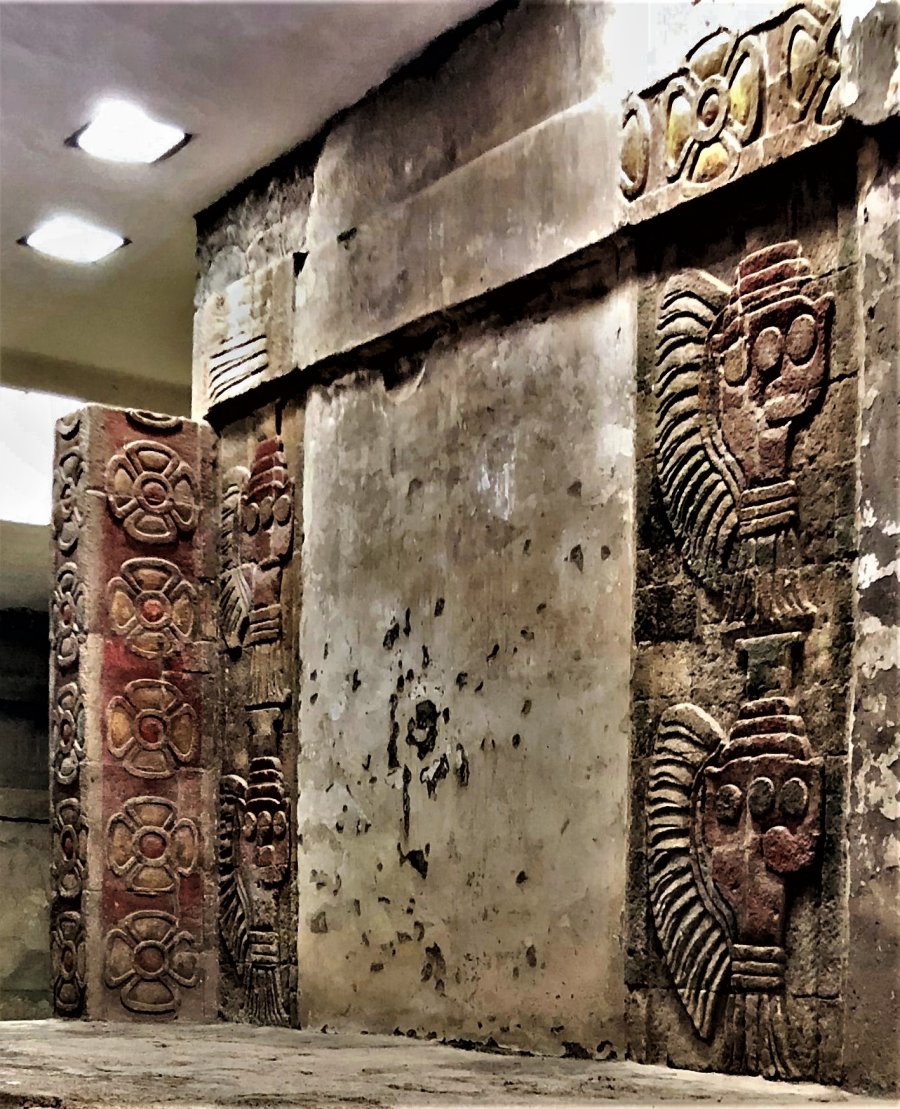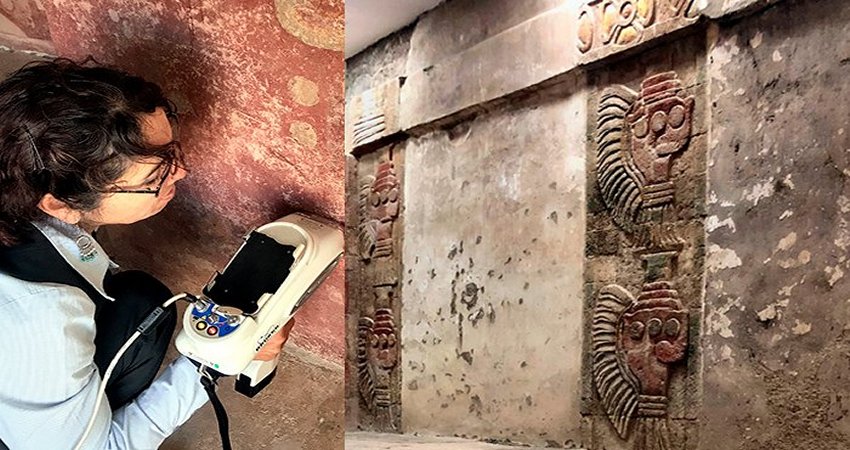Conny Waters – MessageToEagle.com – Researchers from (National Institute of Anthropology and History ) INAH confirm for the first time, the use of cinnabar, a mercury sulfide, applied directly to the mural painting of the Quetzalpapálotl Complex.

Researchers detected use of cinnabar and hematite in early Teotihuacan murals. Photo: Denisse Argote Espino. INAH
This is the first time that the use of cinnabar, a sulfide of mercury, applied directly to early mural painting, has been confirmed, as it had only been identified in loose fragments dated to the last stages of the metropolis’ stylistic and technological development, between 350 and 550 AD, reports INAH researcher, Denisse Argote Espino.
An interdisciplinary team from INAH and UNAM (National Autonomous University of Mexico) also detected the presence of plaster in the stucco, a material that had not been reported.
Teotihuacan was colorful, but red prevailed in its murals, associated with blood, life, fertility and the rebirth of the sun. Non-invasive analysis carried out on the mural painting of various spaces of the architectural complex of Quetzalpapálotl revealed that cinnabar and hematite were used to achieve reddish tones in the early decorations of the city, between the years 200 and 350 AD, write INAH.
source – INAH
The specialist is part of an interdisciplinary team of INAH that, in collaboration with experts from the Center for Applied Physics and Advanced Technology (CFATA) and the Institute of Geology, of the National Autonomous University of Mexico (UNAM), has contributed their grain of sand to the study of polychromy in the great city of the Mesoamerican Classic period, providing a different perspective in the light of new data.
In addition to the presence of cinnabar and hematite in Teotihuacan murals, the experts also detected the use of plaster in stucco. New techniques (like for example, X-ray fluorescence spectrometry) contributed much to the study of mural painting.
The study focused on mural paintings from four spaces of the Quezalpapálotl Complex, an architectural complex located southwest of the Plaza de la Luna, where structures from early and late phases can be found. These spaces are the Palace of the same name (Quetzalpapálotl), the Patio de los Jaguares, the Temple of the Feathered Snails, and the South Complex.
“We chose these sections because they all contain medium and light red tones in their pictorial composition. Only a few included shades of orange-red, such as the frame of a door in the Feathered Snail Substructure and a monochromatic wall in the South Complex,” researchers said.
To this study’s results contributed also Denisse Argote, Gloria Torres, Genoveva Hernández-Padrón, Verónica Ortega, Pedro A. López-García y Víctor M. Castaño.
An interdisciplinary team of INAH and UNAM also detected the presence of plaster in the stucco, which had not been reported. Photo: Denisse Argote Espino. INAH.
Cinnabar was revealed in the Temple of the Feathered Snails: in the representations of flowers with four petals and the body of the seashells, as well as under the blue pigments of the quetzal feathers embodied in the Palace of Quetzalpapálotl, in the central courtyard. The rest of the cases showed the application of iron oxides such as hematite, in different shades.
“Thus, through the pXRF technique, we were able to verify the presence of cinnabar and hematite in the Teotihuacan wall paintings, from the second technical stage. The Temple of the Feathered Snails dates from the Early Tlamimilolpa phase (200-250 AD), while the Palace of Quetzalpapálotl is contemporary to the Early Xolalpan phase (around 350 AD) ”.
The application of cinnabar in the architecture of the first periods within this ceremonial context – they add – “was probably designed to represent rituals, consolidate their religious structure and consecrate the spaces and the people who occupied them”.
As pointed out by the researchers, assigned to the Directorate of Archaeological Studies, the Archaeological Zone of Teotihuacan and the Postgraduate Archeology of the ENAH, unlike hematite, only a few locations of mercury deposits contain crystallized or abundant cinnabar.
The scarcity and absence of cinnabar required it to be imported to the Central Highlands from other areas (probably from the Sierra Gorda queretana or from the areas of Guerrero or Michoacán). Hence, it was one of the most expensive and symbolic pigments in the pre-Hispanic palette, which explains why its use was limited to specific decorative elements and was related to higher social hierarchies, such as those that resided in the Quetzalpapálotl complex.
source – INAH
“This mineral was also a symbol of wealth, power, and magical properties related to the gods of the underworld. Cinnabar is highly esteemed not only in its rarity, but also in the chemical peculiarities of the pigment, since the color behavior is similar to that of blood, which gives it a special connection.”
The above could justify its use in elements with a strong symbolic charge, such as the representations of seashells and four-petal flowers (which allude to the cosmos, the origin of life and the watery underworld) in the Temple of the Feathered Snails. , as well as in the profiles of the quetzal painted in the Palace of Quetzalpapálotl that, although it refers to life, water and fertility (associated with its green color), it could also be an emblem of a dominant lineage of Teotihuacan.
Within the framework of the “Contigo en la Distancia” campaign by the Ministry of Culture, Dr. Denisse Argote details that for the use of cinnabar on lime-based stucco, a previous layer of hematite was applied with a fresco technique and on top powdered cinnabar and a binder were placed for better adhesion. The underlying layer of hematite prevented the mercury sulfide from losing its intensity of color when mixed with the wet calcium-based stucco.
“In the case of the Temple of the Feathered Seashells, this treatment was not necessary, the pigments were applied directly on the basalt blocks of the pillar and the façade.”
Another technological achievement is represented by the use of gypsum in the production of stucco that, in the case of Teotihuacan, had not been reported. For this research, the pXRF technique was tested for the use of supports based on lime and plaster, specifically in the Platform of the Red Circles (a contemporary of the Temple of the Feathered Snails) and in the Palace of Quetzalpapálotl.
See also: More Archaeology News
Additional analyzes with SEM-EDS and Raman spectroscopic instruments corroborate the positive identification of gypsum as part of the bases.
Since it is a less resistant material, it is likely that this calcium sulfate was used in murals with paintings and decorations that are finer and less exposed to the environment. The fact that it will be detected in larger concentrations in the later stages of Teotihuacan mural painting, “tells us about a change in stucco production technology, a subject that should be studied in more detail in future research”, concludes the team of specialists.
Written by Conny Waters – MessageToEagle.com – AncientPages.com Staff Writer







